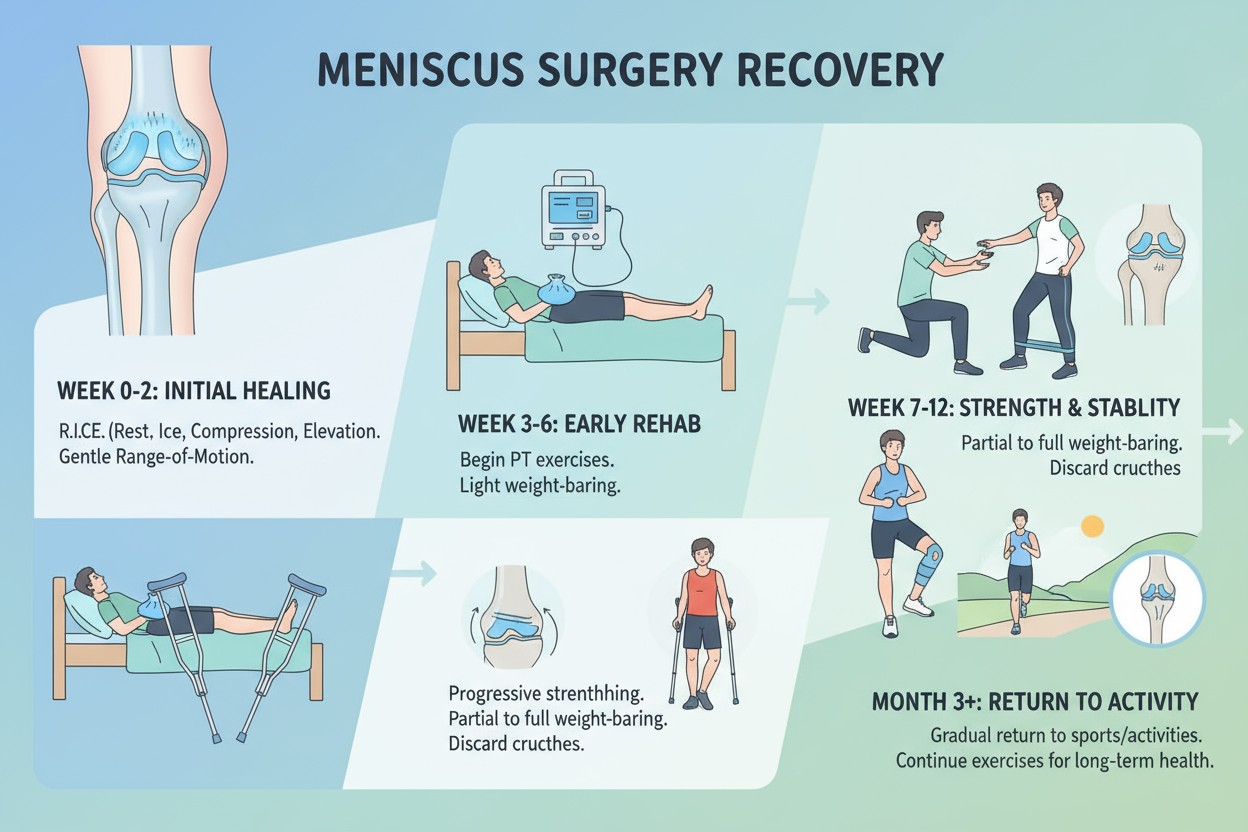Meniscus surgery typically takes about 3 to 6 months to fully heal, depending on the type of tear, the surgical technique, and how closely the patient follows their rehabilitation plan. Some people recover in as little as 6 weeks after a simple meniscectomy, while others may need several months for a full recovery following a meniscus repair. Using proper knee support or a knee brace during recovery can play a vital role in protecting the joint and promoting healing.
Understanding the Meniscus Tear
A Meniscus Tear is one of the most common knee injuries, especially among athletes or individuals who engage in activities that involve twisting or pivoting motions. The meniscus is a C shaped piece of cartilage that acts as a cushion between the thighbone (femur) and the shinbone (tibia). When it tears, pain, swelling, stiffness, and limited range of motion often follow.
In many cases, minor tears can heal on their own with rest and physical therapy. However, more severe tears especially those that affect the blood poor regions of the meniscus may require surgical intervention.
Types of Meniscus Surgery
There are two primary surgical options for treating a meniscus tear:
-
Meniscectomy (Partial or Total Removal):
In this procedure, the damaged portion of the meniscus is trimmed away. It’s a relatively quick surgery, and recovery time is shorter because there is no need for the cartilage to heal only the surrounding tissue. -
Meniscus Repair:
This procedure involves stitching the torn edges of the meniscus back together. Because the meniscus tissue must heal, recovery is longer and requires more careful post-surgical protection and rehabilitation.
Recovery Timeline: What to Expect
Healing time varies depending on the type of surgery, the patient’s age, fitness level, and adherence to post-operative care. Below is a general timeline for recovery after meniscus surgery:
1. First Two Weeks: Rest and Protection
- Swelling and pain are at their peak during the first few days.
- Patients often use crutches and a knee support brace to stabilize the joint and prevent unnecessary movement.
- Gentle range of motion exercises may begin under medical supervision.
2. Weeks 3-6: Gradual Mobility and Strength
- Swelling typically decreases.
- Physical therapy intensifies with strengthening exercises for the quadriceps and hamstrings.
- For those who had a meniscectomy, walking without crutches might be possible by the end of this phase.
- For those who had a meniscus repair, weight bearing is still limited to protect the healing tissue.
3. Weeks 6-12: Rebuilding Functionality
- Range of motion improves, and daily activities can often resume.
- A knee brace or knee support continues to provide stability during more active movements.
- Physical therapy focuses on balance, flexibility, and regaining confidence in the joint.
4. 3-6 Months: Return to Normal Activity
- By three months, most patients can return to low-impact activities like walking, cycling, or swimming.
- High impact activities such as running, jumping, or contact sports are usually cleared closer to six months after surgery especially following a repair procedure.
The Role of a Knee Brace in Recovery
Wearing a knee support brace after meniscus surgery can significantly improve recovery outcomes. It helps by:
- Stabilizing the knee joint to prevent excessive movement during early healing.
- Reducing pain and swelling by providing gentle compression.
- Enhancing confidence during physical therapy and gradual return to movement.
There are different types of knee braces, including hinged braces for post surgical support and compression sleeves for lighter stabilization. Your orthopedic specialist will recommend the best type for your specific injury and stage of recovery.
When Can You Walk Without Support?
Walking without assistance depends largely on the type of meniscus surgery:
- After a meniscectomy: Most patients can walk without crutches within 2-4 weeks, depending on comfort and strength.
- After a repair: It may take 6-8 weeks before putting full weight on the leg, as the sutured tissue needs time to heal.
A gradual transition guided by your physical therapist ensures that you don’t stress the healing tissue too soon.
Factors That Affect Healing Time
Not everyone heals at the same pace. The following factors can influence your recovery period:
- Age: Younger patients tend to heal faster due to better blood flow and tissue regeneration.
- Tear Location: Tears near the outer edge (the “red zone”) heal faster than those in the inner region (the “white zone”) because of better blood supply.
- Type of Surgery: A meniscectomy has a shorter recovery than a meniscus repair.
- Post Surgery Care: Commitment to physical therapy, use of a knee support brace, and avoiding premature strain all contribute to better outcomes.
- Overall Health: Nutrition, hydration, and avoiding smoking or alcohol can significantly impact healing speed.
Physical Therapy and Strength Training
Physical therapy begins soon after surgery and plays a crucial role in regaining full functionality. A structured program typically includes:
- Range of Motion Exercises: To prevent stiffness and improve joint flexibility.
- Strengthening Workouts: Focusing on the quadriceps, hamstrings, and calves for better knee stability.
- Balance and Coordination Drills: To restore control during movement.
- Gradual Return to Sport-Specific Training: Usually introduced around the 4-6 month mark, depending on recovery progress.
Your therapist may also recommend using a knee support during exercises to reduce stress on the joint.
Long Term Knee Care
Even after healing, maintaining knee health is essential. Here are key tips for long-term joint care:
- Continue low-impact exercises like cycling, swimming, or yoga to keep the knee strong and flexible.
- Use a knee brace during high intensity activities or sports to prevent re-injury.
- Maintain a healthy weight to reduce strain on the knees.
- Stretch before and after workouts to improve flexibility and joint mobility.
- Listen to your body pain or swelling after activity is a sign to rest and recover.
When to Contact Your Doctor
You should contact your surgeon or physical therapist if you experience:
- Persistent pain or swelling beyond the expected recovery period
- Instability or locking in the knee
- Redness, warmth, or drainage (possible infection)
- Difficulty regaining motion despite therapy
Prompt evaluation helps prevent complications and ensures the best long term results.
Conclusion
In summary, meniscus surgery recovery takes about 3 to 6 months, depending on the type of procedure and the individual’s healing response. A knee support brace is often essential for protection and stability during this period. With proper care, consistent physical therapy, and patience, most people regain full function and return to their normal activities stronger and more confident than before.









